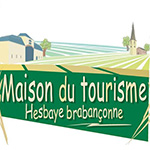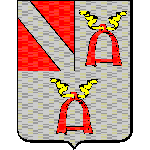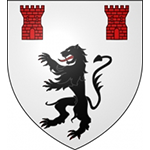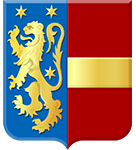Tourism in Hesbaye Brabant
A landscape of cultures, scattered groves and valleys, Brabant Hesbaye has many qualities that will guarantee the success of your excursions. You will discover, over one or other signposted walks, the many Romanesque churches and chapels, the burial mounds, the majestic farmhouses with courtyards, and the beautiful and luminous Gobertange stone.
BRABANT HESBAYE
Agriculture still shapes the identity of this territory consisting of Beauvechain, Hélécine, Incourt, Jodoigne, Orp-Jauche, Perwez and Ramillies. In the midst of these particularly fertile silty lands, criss-crossed by the Great and the Little Gette (streams), there are proud “censes”. Of ecclesiastical or seigneurial origin, these huge quadrilateral farmhouses are the major example of the regional agricultural architecture.
The House of tourism Brabant Hesbaye
The Brabant Hesbaye house of tourism provides a welcome and information for tourists about the seven communes of the canton of Jodoigne. It also helps promote the area, which has multiple natural, geological, heritage, historical, folkloric and gastronomic riches. A key asset for the house of tourism is its location; the east of the Walloon Brabant province is close to the language border and neighbours several other provinces (Flemish Brabant, Liège, Limburg and Namur).
GAL Culturalité in Brabant Hesbaye
The cultural local action group (GAL) is a non-profit organisation whose main vocation is the rural development of the communes of Beauvechain, Hélécine, Incourt, Jodoigne, Orp-Jauche, Perwez and Ramillies. This local action group coordinates multi-thematic projects in partnership with citizens and actors, public or private, from Brabant Hesbaye. Its objective is to put rural life at the heart of its actions, and to consider how rural life might evolve while preserving the environment and rural heritage, and stimulating social cohesion, conviviality and the rural economy…
Beauvechain municipality
Located at the edge of the Meerdael forest and watered by the Néthen river, Beauvechain comprises the villages of Beauvechain, Hamme-Mille, L’Ecluse, Nodebais and Tourinnes-La-Grosse. From the Château de Valduc to the Wahenges farm, the Beauvechain locality is enjoying a renewed conviviality, which makes it one of the most active parts of Walloon Brabant. The diversity of its old villages and neighbourhoods also contributes to its charm.
Hélécine municipality
Located in the extreme east of Walloon Brabant, in a green setting, the Hélécine locality encompasses the villages of Linsmeau, Neerheylissem and Opheylissem. It is the least populated commune of Walloon Brabant. Rich in historical and architectural heritage that is well worth seeing, Hélécine owes its fame, among other things, to its Abbey, now a provincial domain, but also to its beautiful churches and chapels. Halfway between Liège and Brussels, and with the Litte Gette winding its way through it, the commune offers the typical image of a Brabant village nestled in the greenery.
Incourt municipality
Incourt is the commune of Jodoigne with the most traces of ancient history. It encompasses the villages of Glimes, Incourt, Opprebais, Sart-Risbart, Piétrebais, Chapelle-Saint-Laurent and Roux-Miroir, and is watered by the Great Gette, the Thorembais, the Orbais, the Brombais and the Piétrebais streams. Incourt has many vestiges of the past : the burial mound of Glimes dating from the Gallo-Roman period, the medieval castle farm of Opprebais, the “Gustot” windmill in Opprebais, the Chise farms at Piétrebais, the Opprebais quarry – testament to the industrial past of the commune.
Jodoigne municipality
Capital of Brabant Hesbaye, Jodoigne is a commercial and agricultural municipality grouping together the villages of Dongelberg, Jauchelette, Jodoigne-Souverain, Lathuy, Mélin, Piétrain, Saint-Jean-Geest, Saint-Rémy-Geest and Zetrud-Lumay. Spread out on the banks of the Gette, in a loop where the slope of the Hesbaye plateau departs from the river, Jodoigne is a city that prides itself on a past rich in adventure. Jodoigne appeared in the 12th century – it was created by Duke Henri of Brabant – amid the rise of the medieval urban movement.
Orp-Jauche municipality
The Orp-Jauche municipality encompasses the villages of Enines, Folx-les-caves, Jandrain-Jandrenouille, Jauche, Marilles, Noduwez, Orp-le-Grand and Orp-le-Petit and is watered by the Little Gette. In the second half of the nineteenth century and the first years of the twentieth century, Orp-Jauche experienced an important economic, industrial and commercial boom, aided by the opening of the Tamines-Landen railway in 1865. The gradual disappearance, in the last fifty years, of its industrial fabric has given the commune back its essentially rural character of yesteryear.
Perwez municipality
Located in the southeast of Walloon Brabant, in the heart of Hesbaye, the Perwez locality comprises five villages : Malèves-Sainte-Marie-Wastines, Orbais, Perwez, Thorembais-Les-Béguines and Thorembais-Saint-Trond. The territory of Perwez forms a vast plain covered mainly by fields and meadows stretching in gentle slopes – typical Hesbaye landscape. With a slightly uneven terrain, its altitude varies between 136m and 174 m. Perwez’ highest point – and that of Walloon Brabant – is the Gadaffe farm. Several rivers, with peaceful and gently winding paths, take their source in the commune.
Ramillies municipality
The Ramillies locality is the result of the merger of the communes in 1977 and includes the villages of Autres-Eglise Hédenge hamlet, Geest-Gerompont, Petit-Rosière, Bomal, Mont-Saint-André, Grand-Rosière-Hottomont and the Hottomont hamlet, Huppaye and Molembais-Saint-Pierre hamlet and Ramillies-Offus. Ramillies owes its fame to its central position during the famous battle that took place on the day of Pentecost in 1706 between the Anglo-Dutch allied forces and the French forces during the War of the Spanish Succession.










